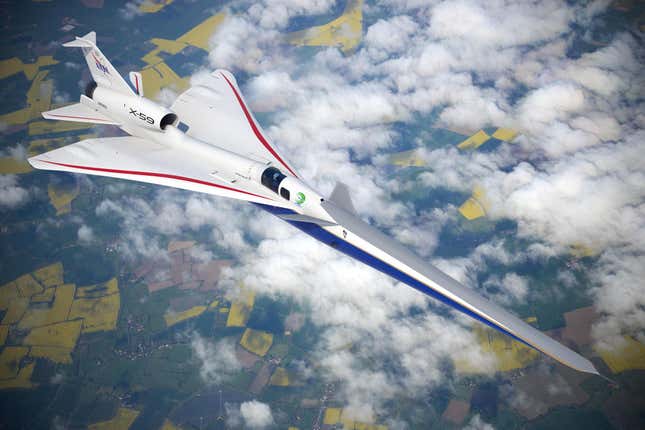NASA’s supersonic experimental plane—the linchpin of the agency’s Quesst mission—is set to roll out of its warehouse in the California desert next week. We’re gassed for the big moment: the X-59 has been in development for six years, and, if successful, it will demonstrate supersonic flight without sonic booms.
The 99-foot-long (30-meter) plane is just 14 feet (4.27 meters) tall, making it look needle-like from the side. The single-engine jet will have a cruise altitude of 55,000 feet (16,764 meters) and will be capable of speeds up to 925 mph (1,489 kmph), or Mach 1.4. But here’s the kicker: The plane will only create a perceived sound of 75 PLdB, or about as loud as a car door closing, according to Lockheed Martin, whose Skunk Works team collaborated with NASA to develop the experimental aircraft.
Advertisement
Loud sonic booms occur when an object travels faster than the soundwaves it produces. While the booms cannot be heard by those aboard the speeding object—as they are traveling faster than sound—on the ground, the shock waves can damage buildings, panic animals, and generally be a nuisance for anyone within earshot.
Advertisement
With the X-59, NASA seeks to demonstrate supersonic flight with a muffled boom—a “sonic thump,” as they call it. The experimental plane was originally expected to make its first flight in 2023. But in aeronautics, nothing slips like a schedule, and more time was needed to integrate some of the aircraft’s systems and fix some recurring issues in its computers, according to a NASA release. The plane also underwent structural testing and ground tests.
Advertisement

Though the X-59 research aircraft is a bright mint green, the aircraft to be revealed next week will be red, white, and blue. Besides the patriotic aesthetic, the new paint job will protect the plane from moisture and corrosion. NASA has put out invitations, printable decorations, and some themed food ideas for anyone wanting to celebrate the roll-out, which you can watch on the agency’s website at 4 p.m. EST on Friday, January 12.
Advertisement
When we talk about supersonic aircraft, it is hard not to mention the Concorde, the supersonic commercial jet that made its final flight in 2003. Years before that—and indeed, before the fatal crash in 2000 that killed 113 people—the costs of supersonic travel were rising, according to the Museum of Flight. Their sonic booms meant the planes could only go supersonic over the ocean, as the powerful shockwaves could shatter glass on the ground. Cities issued noise complaints over (or rather, under) the Concorde’s earsplitting schlepps, and today we commercial travelers all fly slower than sound.
Now we’re inching very close to the aircraft’s first flight, slated for sometime this year. That will only mark the beginning of the X-59’s Phase 1. In Phase 2, the X-59’s quiet supersonic technology and the aircraft’s actual performance will be tested out in the air. Then, starting in 2026, the X-59’s third and final phase will involve flying the plane over several U.S. cities and surveying residents to determine the invasiveness of the aircraft’s supersonic presence. The entire mission is expected to run through 2027.
Advertisement
Currently, the Federal Aviation Administration does not allow civil aircraft to travel over speeds exceeding Mach 1. But in the next several years, the Quesst mission—vis-a-vis the elegant X-59—will test out the disruptiveness of sonic thumps. NASA will provide the data it collects to regulators, which could cause the rules around commercial supersonic flight over land to change.
More: 12 of the Weirdest X-Plane Designs
Services Marketplace – Listings, Bookings & Reviews